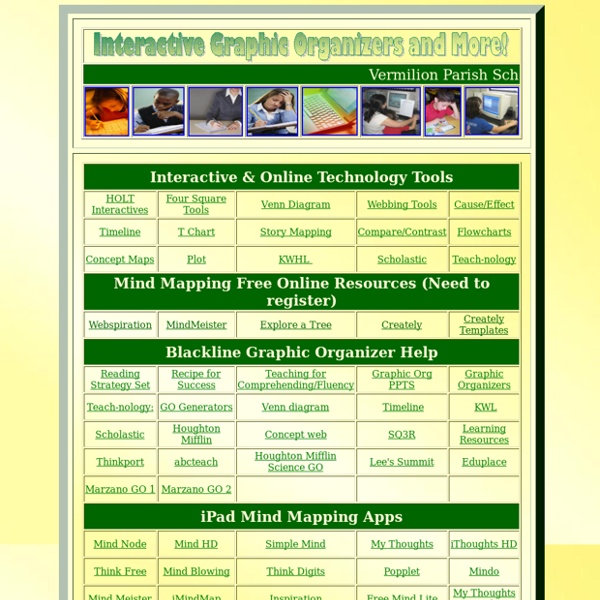Graphic Organizer Interactives & 18 Literacy Strategy Site (Vermilion Parish)
Click here for the new Vermilion Parish Interactives for the Louisiana 18 Literacy Strategies! *The new interactive links below were shared via twiiter by Adam Brice (@adambrice via via @SimplyBox) Vermilion Parish Curriculum Page Vermilion Parish Schools Testing Links Graphic Organizers 18 Literacy Strategies Vermilion Parish Schools (Louisiana) Note: Most sites need Java. Adobe Flash, Shockwave, or Adobe Acrobat Reader To report broken links or comments, please email Stacy Bodin. Email Questions
http://www.vrml.k12.la.us/graphorgan/
Related: Miscellaneous
Glossary of Instructional Strategies
Current number of strategies and methods: 1271 Last updated: 27 July, 2013 Definitions written by Kelly Jo Rowan. ©1996-2013 Kelly Jo Rowan. 10 + 2 (Ten Plus Two)
Differentiated Instruction Made Easier
Shuana Jordan Product Manager Differentiated instruction creates a learning environment that motivates students to learn and helps meet the diverse needs of individual students. Technology supports differentiated instruction and provides the opportunity to improve teaching and learning. Below are instructional strategies that will encourage differentiated instruction, along with examples of how to apply these basic strategies and recommendations for supporting technology. Tiered strategy
8 Exam-Prep Activities Students Actually Like
After Christmas break students will return to school for 8 days of review prior to taking their End of Course Exams. I can give my students a review packet with hundreds of problems, but that would only lead to them giving up, sleeping, and not even trying. So below are 8 fun activities I created to motivate and engage my students in their final exam reviews. 1. Vocabulary Gallery Walk – Each student will be given a word to define and provide an example for.
Mad Science Station Labs – Plug and Play Science Stations
I have re-invented how station labs are going to look in my classroom and wanted to shared with you what I believe a much better solution to the traditional science station lab. I’ve developed a system that I’m calling the Mad Science Station Labs Series. It is a plug in play system that allows the station to remain somewhat consistent throughout the year, but allows the teacher to interchange the content very quickly. There are eight total labs stations that the students will visit.
Professional Learning Community (PLC) - Deer Creek Schools
Deer Creek Public Schools Professional Learning Communities A Big Picture Look at Professional Learning Communities What is a PLC? “A Professional Learning Community (PLC) is educators committed to working collaboratively in ongoing processes of collective inquiry and action research to achieve better results for the students they serve.
Discourse Tools
Related:



